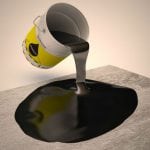Organosilicon enamel among a huge number of paint products stands out for its special unique properties. Based on the organosilicon compound, paints are created that have exceptional resistance to high and low temperatures, which made them popular in many industries and construction.
- Special properties
- Areas of use
- Surface preparation
- Preparation of dyes for surface application
- Surface painting

Special properties
Paints based on organosilicon compounds have a number of positive characteristics:
- They have high thermal stability and frost resistance (tolerate temperature fluctuations up to 60 degrees).
- They have excellent water resistance.
- They perfectly tolerate the impact of an aggressive environment.
- Do not fade or change color under the influence of ultraviolet rays.
- The industry produces a large number of different colors of these varnishes and paints, which makes it possible to easily select the desired shade.
- Low paint consumption when coating surfaces makes these materials economically viable.
- They are inexpensive.
- Perfectly applied on surfaces at temperatures from –20 degrees to + 40.
- Provide metal coated with such coatings with high corrosion protection.
The disadvantage of varnish enamels based on organosilicon compounds is the high toxicity of fumes when dried. With prolonged contact with them, a person experiences a reaction as to narcotic substances.
In this regard, such materials are used exclusively for outdoor street work. If paint work is carried out indoors, a respirator must be used.
to contents ↑Areas of use
Most often, organosilicon paint and varnish are used during external finishing works in construction. Due to their technical characteristics such as resistance to atmospheric precipitation and durability, these materials are used to cover the surfaces of facades and street buildings.
Such paints not only create protection for the surface of buildings and structures, they are able to perfectly decorate and adorn them. These paints and varnishes adhere perfectly to surfaces:
- plasters;
- concrete;
- brick;
- stone;
- slate;
- various metals.
The paint and varnish covering layer applied on the surface of chimneys, chimneys, electric furnaces, tolerates particularly high temperatures without changing color and violating the durability and integrity of the surface.
Due to the special refractory and insulating properties, varnishes and paints based on organosilicon are used for painting products used in everyday life for cooking and tolerate frequent heating.
For these purposes, special paints and varnishes are used, which belong to the group of food varnishes approved for coating products in contact with food products of people and animals.
In accordance with sanitary and food requirements, these materials are of two types:
- Varnishes and paints that have permission to use on any surface without restriction. Such materials are suitable for use for any purpose, including in public buildings, hospitals, kindergartens and schools.
- Paints and varnishes having restrictions and allowed for some types of work.
Paints and varnishes having permission for their unlimited use are often used to coat the inner surfaces of tin cans.
to contents ↑Surface preparation
Any paints and varnishes, including those made with the use of organosilicon compounds, must be applied to the painted objects, strictly observing the technology of painting work.
If it comes to coating metals, you should first clean the product from dirt, traces of oils, rust, residues of old paint. After all contaminants are removed, the cleaned metal must be degreased. Surface degreasing is done with solvents.
Cleaning surfaces for painting are carried out manually or mechanically. If necessary, some surfaces are coated with one or two coats of primer mixes, compatible with paints and varnishes, before painting.
Consumption of primers and paints depends on the area of the surface to be coated, the number of layers and the quality of the substrate to be coated. For painting concrete or brick, a larger amount of soil and paint will be needed than when applying them to metals.
After priming, it is necessary to postpone further painting work for a while to allow the soil to dry completely. Organosilicon compounds are not applied to wet surfaces covered with dew, hoarfrost, snow.
to contents ↑Preparation of dyes for surface application
Organosilicon enamel is sold ready to use, and you do not need to make any manipulations before using it. If it is thickened for some reason, it can be diluted to the required consistency with xylene or toluene. After the diluents are added to the main coloring composition, the resulting mixture must be thoroughly mixed.
to contents ↑It is not recommended to dilute varnishes and paints in order to reduce their consumption, since in this case the film formed by diluted paint will have lower strength and quality indicators, its decorativeness and water resistance will decrease.
Surface painting
Silicone-based enamels, varnishes and paints can be applied:
- airbrush;
- spray gun;
- manual painting with a brush or roller;
- by immersing the product in a coloring matter.
Staining can be done at ambient temperatures from –20 to +40 degrees Celsius. The only prerequisite is that the painted surface must be completely dry.
Metal surfaces are painted in two or three layers, the concrete, plaster, cement and brick paints are coated in three layers. Before applying each subsequent layer, the previous one is allowed to dry. The more porous and loose the substrate, the higher the consumption of paints and varnishes.
Such remarkable properties of organosilicon enamels and paints, their high level of heat resistance, durability and special strength, made them especially in demand in production, construction and everyday life.








What primers do you recommend applying under co-enamels? And it is possible to apply ko to pure metal.